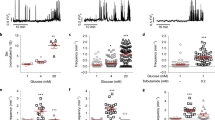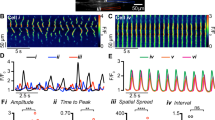Abstract
THE pancreatic acinar cell discharges secretory proteins in response to cholecystokinin–pancreozymin (CCK–PZ) and its analogues, or to cholinergic agonists such as carbamylcholine (carbachol). The mechanisms for stimulus–secretion coupling in the acinar cell are not known, although intracellular and, to some extent, extracellular Ca2+ are required1–4, and a transient 10- to 20-fold increase in intracellular levels of guanosine cyclic 3′5′-monophosphate (cyclic GMP) accompanies onset of induced discharge5,6. It has been proposed5 that cyclic GMP may be a direct mediator of hormone-stimulated discharge, with the Ca2+-dependent event either causing, or being caused by, increases in cyclic GMP7,8. To test this hypothesis, we have monitored the effects of several substances on secretory protein discharge and intracellular cyclic GMP levels in guinea pig pancreatic acini. Our results, reported here, are not consistent with a role for cyclic GMP in a direct causative pathway leading to discharge, as four of the compounds tested (N-methyl-N-nitro-N-nitrosoguanidine (MNNG), sodium nitrite, hydroxyl-amine and sodium nitroprusside) elevated levels of cyclic GMP but did not trigger discharge, although acini treated with these agents remained competent to respond to natural secretagogues. Conversely, the phorbol ester 12-O-tetradecanoyl-phorbol-13-acetate (TPA) did not affect cyclic GMP levels, but did elicit discharge. In contrast to observations on cyclic GMP, the requirement for extracellular Ca2+ correlated well with discharge. Our findings therefore do not support the hypothesis that cyclic GMP is directly involved in stimulus–secretion coupling, but are consistent with such a role for Ca2+. A preliminary report of this work has appeared9.
This is a preview of subscription content, access via your institution
Access options
Subscribe to this journal
Receive 51 print issues and online access
$199.00 per year
only $3.90 per issue
Buy this article
- Purchase on Springer Link
- Instant access to full article PDF
Prices may be subject to local taxes which are calculated during checkout
Similar content being viewed by others
References
Williams, J. A. & Chandler, D. Am. J. Physiol. 228, 1729–1732 (1975).
Kano, T. & Nishimura, O. J. Physiol., Lond. 257, 309–324 (1976).
Chandler, D. E. & Williams, J. A. J. Cell Biol. 76, 371–385 (1978).
Williams, J. A. Cell Tissue Res. 192, 277–284 (1978).
Haymovits, A. & Scheele, G. A. Proc. natn. Acad. Sci. U.S.A. 73, 156–160 (1976).
Albano, J., Bhoola, K. D. & Harvey, R. F. Nature 262, 404–406 (1976).
Scheele, G. A. & Haymovits, A. Ann. N.Y. Acad. Sci. 307, 648–652 (1978).
Christophe, J. P., Frandsen, E. K., Conlon, T. P., Krishna, G. & Gardner, J. D. J. biol. Chem. 251, 4640–4645 (1976).
Gunther, G. R. & Jamieson, J. D. J. Cell Biol. 75, 415a (1977).
Boutwell, R. K. Crit. Rev. Tox. 2, 419–443 (1974).
Estensen, R. D. et al. in The Regulation of Proliferation in Animal Cells (ed. Clarkson, B. & Baserga, R.) 627–634 (Cold Spring Harbor Laboratory, New York, 1974).
White, J. G., Goldberg, N. D., Estensen, R. D., Haddox, M. K. & Rao, G. H. R. J. clin. Invest. 52, 89a (1973).
DeRubertis, F. R. & Craven, P. A. Science 193, 897–899 (1976).
Kimura, H., Mittal, C. K. & Murad, F. J. biol. Chem. 250, 8016–8022 (1975).
Kimura, H., Mittal, C. K. & Murad, F. Nature 257, 700–702 (1975).
Katsuki, S. & Murad, F. Molec. Pharmac. 13, 330–341 (1977).
Schultz, K.-D., Schultz, K. & Schultz, G. Nature 265, 750–751 (1977).
Haddox, M. K. et al. in Growth Kinetics and Biochemical Regulation of Normal and Malignant Cells (eds Drewinko, B. & Humphrey, R. M.) 255–269 (Williams and Wilkins, Baltimore, 1977).
Goldberg, D. D. et al. in Advances in Cyclic Nucleotide Research (eds Greengard, P. & Robinson, G. A.) 101–130 (Raven, New York, 1978).
Haddox, M. K., Stephenson, J. H., Moser, M. E. & Goldgerg, N. D. J. biol. Chem. 253, 3143–3152 (1978).
Erspamer, V. A. Rev. Pharmac. 11, 327–350 (1971).
Kapoor, C. L. & Krishna, G. Science 196, 1003–1005 (1977).
Heisler, S. & Lambert, M. Can. J. Physiol. Pharmac. 56, 395–399 (1978).
Ong, S. H., Whitley, T. H., Stowe, N. W. & Steiner, A. L. Proc. natn. Acad. Sci. U.S.A. 72, 2022–2026 (1975).
Williams, J. A. & Lee, M. Biochem. biophys. Res. Commun. 60, 542–548 (1974).
Gunther, G. R., Schultz, G. S., Hull, B. E., Alicea, H. A. & Jamieson, J. D. J. Cell Biol. 75, 368a (1977).
Amsterdam, A., Solomon, T. E. & Jamieson, J. D. in Meth. Cell Biol. 20, 362–378 (1978).
Matsuzawa, H. & Nirenberg, M. Proc. natn. Acad. Sci. U.S.A. 72, 3472–3476 (1975).
Steiner, A. L., Parker, C. W. & Kipnis, D. M. J. biol. Chem. 247, 1106–1113 (1972).
Burton, K. Biochem. J. 62, 315–323 (1956).
Amsterdam, A. & Jamieson, J. D. J. Cell Biol. 63, 1057–1073 (1974).
Author information
Authors and Affiliations
Rights and permissions
About this article
Cite this article
GUNTHER, G., JAMIESON, J. Increased intracellular cyclic GMP does not correlate with protein discharge from pancreatic acinar cells. Nature 280, 318–320 (1979). https://doi.org/10.1038/280318a0
Received:
Accepted:
Issue Date:
DOI: https://doi.org/10.1038/280318a0
This article is cited by
-
A novel micromethod for pancreatic acinar secretion
International journal of pancreatology (1990)
Comments
By submitting a comment you agree to abide by our Terms and Community Guidelines. If you find something abusive or that does not comply with our terms or guidelines please flag it as inappropriate.



